![]() Showroom Closed - Independence Day (July 4)
Showroom Closed - Independence Day (July 4) ![]()
Showroom Hours Mon-Fri: 8 am - 4:30 pm
Refinish your hardwood floors to bring them back to their original luster or give them a new look.
Hardwood floors become damaged and dull over time so recoating or refinishing is important to extend their life. Refinishing your wood floors can also give your space a completely new look, especially when stained.
Screen & Coat and Refinishing
We are hardwood specialists and one of the only flooring companies that refinishes wood floors in the greater San Jose area.
From prefinished wood to site-installed and hand scraped wood flooring, we can refinish it with either a full sand and finish or a screen and recoat.
Refinishing your hardwood floors is one of the most cost-effective ways to enhance the beauty and value of your home! Contact us for hardwood floor refinishing in San Jose & surrounding areas:
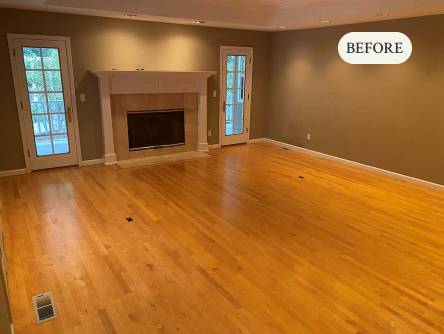
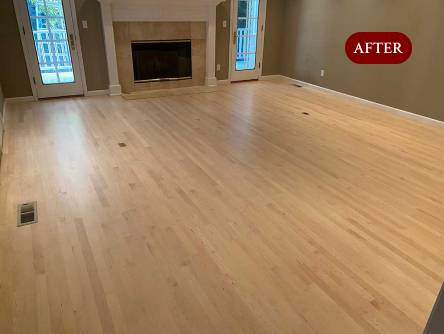
Hardwood Floor Sand and Finish
Sanding and refinishing hardwood floors is one of our specialties, serving the greater San Jose Bay Area, including San Mateo, Santa Clara, and Alameda counties.
A full sand and finish will remove/fix most scratches and discolorations out of your once-gorgeous solid hardwood floors. One of the great positives of a sand/refinish is the option of imagining a whole new look by changing the color and gloss/sheen of the floor. Freshly sanded floors can be stained a different color then finished with a sheen of your choosing.
The process of hardwood floor refinishing typically involves the following steps:
- Sanding: The first step in refinishing a hardwood floor is sanding. The floor is sanded to remove the old finish, scratches, and any imperfections. Before sanding, we set up plastic walls to enclose the area and protect furniture and other rooms from dust. We also fill any gaps or deep gouges in the floor prior to sanding for a perfectly smooth final surface.
- Staining (optional): If you want to change the color of your floor, you can apply a stain before applying the finish. Staining is optional and comes in a huge range of colors and hues. Staining will add a day or 2 to the job, depending on job size and complexity.
- Applying the finish: After sanding and staining (if desired), multiple coats of the finish are applied to the floor. Different types of finishes are available but the most common are oil-based and water-based urethane finishes. Each type of finish has its advantages and disadvantages. Finishes come in a range of gloss types. Learn more about finishes.
- Drying and curing: The finish must dry and cure for maximum durability and protection. The duration of this step depends on the type of finish used, temperature, and humidity levels.
- Cleaning: After the finish has dried and cured, the floor is cleaned to remove any dust or debris.
Hardwood Refinishing Projects
- Prefinished American Walnut sand & finish
- Douglas Fir sand & finish
- Cherry Floors sand, stained, finished
- Dio Deka (restaurant) sand & finish + replacements
- 100 Year Old Floor sand & finish restoration
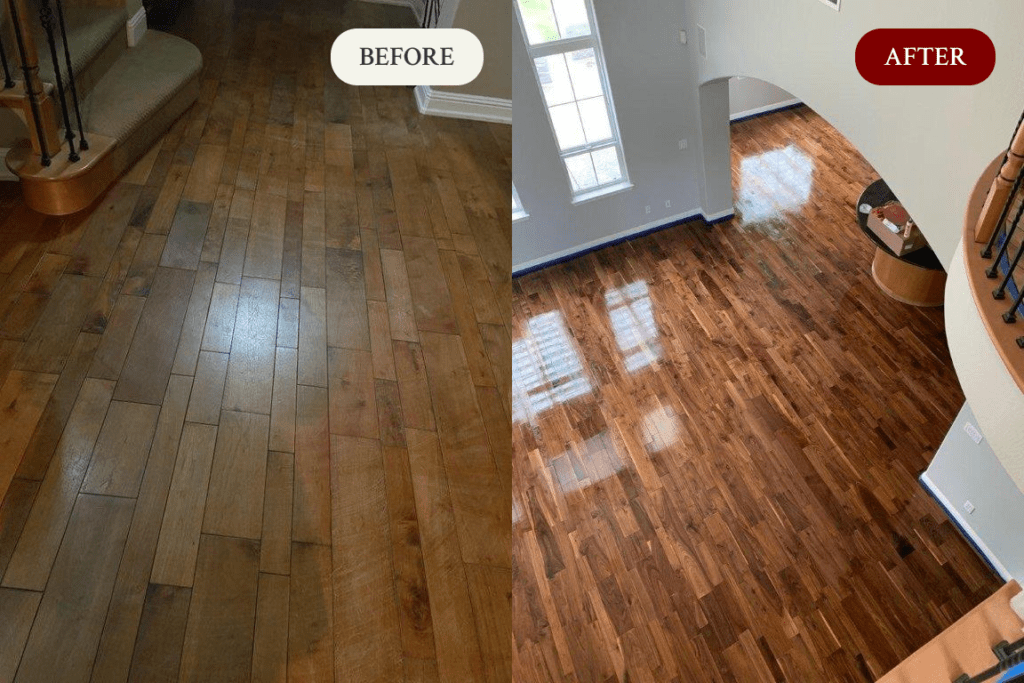
Prefinished engineered American Walnut sand/refinish from stained to natural color.
15 year old floor with heavy scratches & UV discoloration.
![]() Morgan Hill, California
Morgan Hill, California
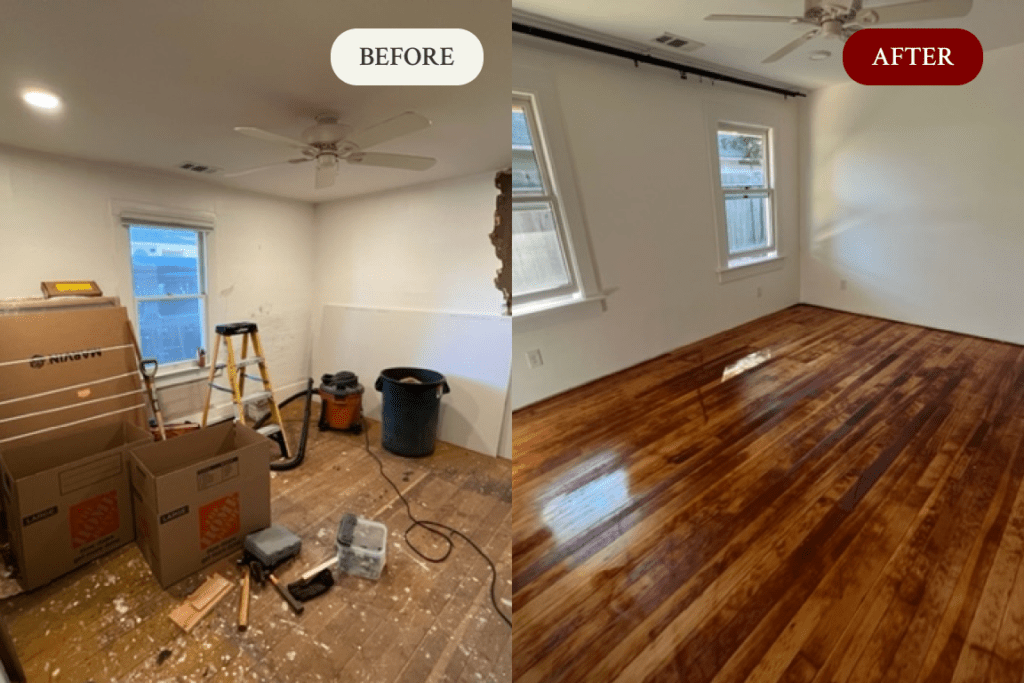
Douglas Fir sand & refinish
![]() Campbell, California
Campbell, California
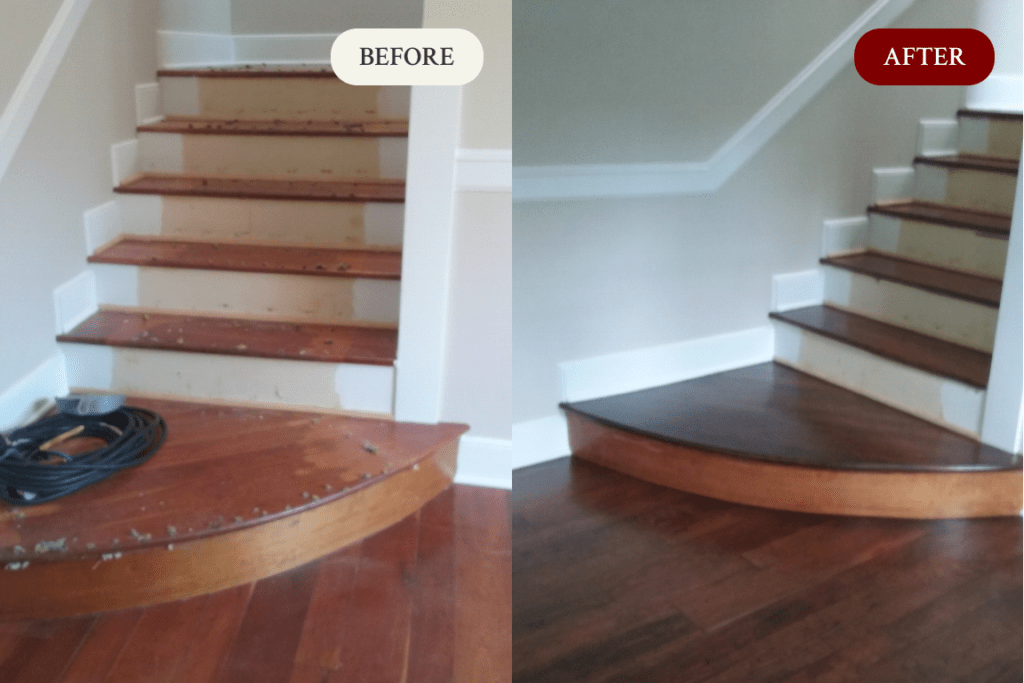
Rare domestic cherry floors in 4, 6, & 8” planks in old home, sanded, stained dark, and finished.
![]() Los Gatos, California
Los Gatos, California
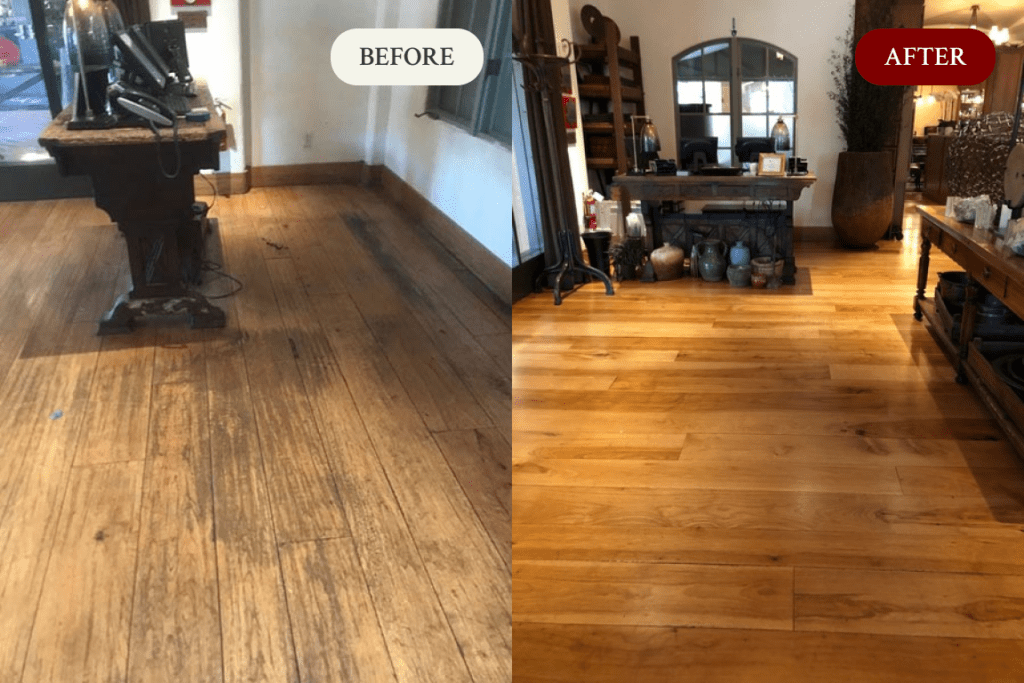
Dio Deka (restaurant) sand & finish entire restaurant and bar – over 5000 sq ft.
![]() Los Gatos, California
Los Gatos, California
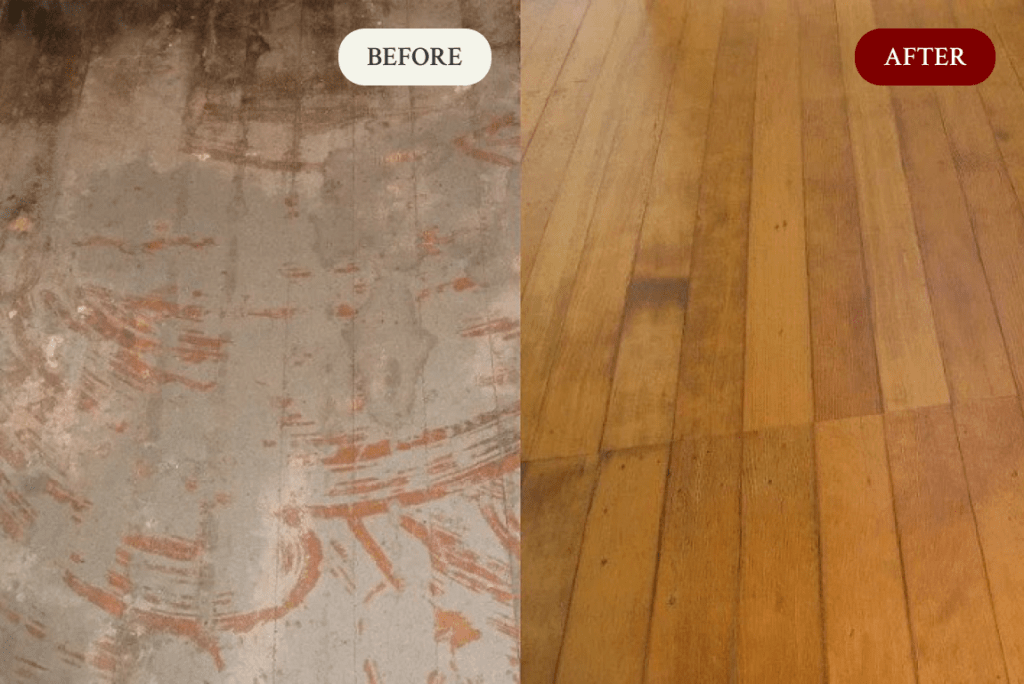
100 Year Old Floor sand & finish restoration
![]() Morgan Hill, California
Morgan Hill, California
Screen & Recoat (Buffing)
Hardwood floors that do not have heavy damage, no deep scratches or staining, can be screened (or buffed) and recoated in place of a full sand and finish. This process can restore wood floors to their original glory, while adding a renewed layer of protection.
Screen and coat is a process that involves mildly scuffing up or abrading the floor (also known as screening), followed by the application of a topcoat of polyurethane finish. This process “renews” the top protective layer of the wood’s finish. It will remove or minimize a lot of the fine scratches and wear which has taken place to the floor over years of use.
Despite the harsh implication of abrading the floor, screening will actually smooth the floors a bit; the mild abrasion is done to allow the polyurethane to stick to the surface more effectively while also removing the light damage accrued on the previous finish over the years.
With a screen and recoat, the color (stain) of the floors cannot be removed or changed. That can only be done with a full sanding. However, a new gloss/sheen can be applied. Older homes may have a glossy finish on their floors. A screen and recoat can remove that finish and replace it with a matte or satin finish, for example.


A screen and coat will not work in other scenarios. If improper cleaning solutions have been used (those with oil or waxes), the screen and coat will not bond to the existing finish. These oils or waxes act as a contaminate (sort of like spraying “Pam” on a pan), and it will not allow a bonding to the prior coats of finish. If you find discolorations in your wood floors like water damage, UV damage, gray spots, or other types of staining, a screen and coat will, more likely than not, be sufficient and a full sand and refinish is necessary.
Remember to always consult with your local flooring store and installer, as well as manufacturer guidelines, to ensure you are properly maintaining your wood floors with the right cleaning products.
Interested in a refinish but not sure if you need a screen & coat or sand & finish?
Contact us for an in-home consultation!
How long does a screen and recoat take?
Screen and coat takes less time than a full sand and finish and is less expensive to have done. It also will create less mess, since there is essentially no dust. Just the screening process takes just a few hours in most cases, depending on the size of the job.
After the initial screening, we apply a fresh coat of finish for long-term protection. The finishing process takes about one day, again depending on the size of the job.
Just like sand and finish, furniture needs to be moved off the floor, but can be back in place roughly 72 hours after the finish is applied (exception: move area rugs back 4 weeks later).
Sand & Refinish vs. Screen & Coat Comparison
| Sand & Refinish | Screen & Coat |
|---|---|
|
Can stain floors to change color
|
Cannot stain floors to change color
|
|
Can change finish sheen (matte, satin, semi-gloss, glossy)
|
Can change finish sheen (matte, satin, semi-gloss, glossy)
|
|
Will fix most heavy scratches
|
Does not work for heavy scratching
|
|
Will fix most discolored floors
|
Does not work for discolored floors
|
|
Can refinish waxed or oiled floors
|
Does not work for waxed or oiled floors
|
|
Protects floors from future damage
|
Protects floors from future damage
|
|
Takes longer than screening: roughly about 3 – 5 days per 1000 square feet
|
Faster than sanding: about 1 day in most situations (project size dependent)
|
|
Can walk with socks after 24 hours, 72 hours with shoes
|
Can walk with socks after 24 hours, 72 hours with shoes
|
|
Move furniture back after 72 hours (water-based finish) or 96 hours (oil-based finish)
|
Move furniture back after 72 hours (water-based finish) or 96 hours (oil-based finish)
|
|
Move area rugs back after 4 weeks once the finish is fully cured
|
Move area rugs back after 4 weeks once the finish is fully cured
|
|
Messier (dust) than screening
|
Less mess than sanding (no dust)
|
|
More expensive than screening
|
Less mess than sanding (no dust)
|
Hardwood Finishes & Stains
A wood floor needs to be coated/finished after it has been sanded to protect it from damage. Finish selection and optional staining are an essential part of the sanding and refinishing process.
Stains can be applied to unfinished floors (or freshly sanded floors) to change their color. There are nearly endless possibilities of stains; they can even be blended to make custom stains. Each stain will have a different look based on the species of wood. Stains also come in different bases, most common being oil-based or water-based.
Staining is optional and many floor owners will opt for the natural color of their wood floors. If a stain is applied, it must be finished and protected by a top coat of polyurethane.
Types of Stains/Finishes
Many different types of stains/finishes are available, but the two most common are oil-based and water-based.
- Oil-based stains and urethanes are the most common type used in refinishing projects. They are easy to apply and come in various colors, from light to dark. Oil-based stains penetrate deep into the wood, enhancing the natural grain pattern and creating a warm, rich color. They are also very durable and resistant to wear and tear.
- Water-based stains and finishes are becoming more popular due to their low VOC content and faster drying time. They come in various colors and can be used on both hardwood and softwood. Water-based stains produce a more uniform color than oil-based stains and are less likely to fade over time. They also have a lower odor, making them a good choice for indoor projects. Water-based products are more green: they use less solvents and are low VOC (Volatile Organic Compounds), making them safer for homes with little ones.
- Gel stains have a thicker consistency than other types, making them ideal for use on vertical surfaces or for creating special effects. They come in various colors and can be applied with a brush or cloth. Gel stains do not penetrate as deeply into the wood as other types of stains, but they are easier to control and can be used to create a variety of finishes.
- Dye stains are made from a water-soluble powder and produce a transparent color that allows the wood’s natural grain to show through. They are ideal for softwood use and can be mixed to create custom colors. Dye stains dry quickly and are less likely to raise the grain of the wood, making them a good choice for projects that require a smooth finish.
The final topcoat finish on the wood floor is a urethane finish which comes in a variety of gloss levels/sheen like matte, satin, semi-gloss, or glossy. The final polyurethane finish can be water-based or oil-based, just like the stain.
| Water-Based Urethane | Oil-Based Urethane |
|---|---|
| Very Good Durability | Very Good Durability |
| Mild Odor | Moderate Odor |
| Clear in Color | Amber in Color |
| Easy to Recoat | Easy to Recoat |
| Fast Drying | Slow Drying |
| Non-Flammable | Combustible |
As previously mentioned, the two most common types of finishes used are oil-based or water-based, but additional specialty finishes are also available:
- Rubio Monocoat: This is a clear or colored No VOC single coat oil finish. It is an environmental alternative finish that can be easily repaired if needed.
- Swedish Finish (or Conversion Varnish): This is the most durable finish available, but it requires special application techniques.
Selecting the right stain and finish has many variables that should be considered, including wood species, activity/usage, household members (pets, children), and personal preferences. Contact us for assistance in selecting the perfect stain and finish for your flooring project!
Unfinished Raw Wood Floors
Floors may also be left unfinished for a raw, natural look. Unfinished floors need to be coated with oil regularly (annually or semi-annually) to retain their look. Oiled floors are highly sensitive and can be damaged from spills far easier than ones coated with a polyurethane finish.
Needless to say, these types of floors are not recommended for homes with children, pets, or rooms with frequent spills or drops (most notably kitchens).
An unfinished floor may also be coated with a traditional wax finish. While it requires maintenance, it also provides a No VOC, deep, low-sheen natural looking floor.
Choosing the right stain for a refinishing project depends on several factors, such as the type of wood being refinished, the desired color and finish, and the level of durability required.
A professional refinishing company can advise which type of stain is best suited for a specific project, with samples of how the floor will roughly look once completed.
Water-Based Coats for Facilities
Our water-based finishing/coating products are specifically designed for sports, dance, and gym floors, where safety is a top priority. These coatings were developed to replace highly flammable and dangerous products used in the past and are low in VOCs, making them safe for the environment and indoor air quality.
These finishes are fast-coating and quick-curing, allowing us to clean and coat dance studios, gyms, restaurants, or basketball courts quickly, with minimal downtime.
Read more: Flooring for Businesses
Fix Severe Hardwood Floor Damage
The goal for a refinish job is to restore the beauty and functionality of the wood surface. This can involve addressing any damage that may be present, whether it is minor or severe.
Minor damage, such as scratches and small dents, can often be fixed during the sanding process.
If the damage is more severe, we typically will use a wood filler to fill in any gaps or holes before applying the finish. This process can help restore the smooth, even surface of the wood and make it look brand new again.
For more significant damage, such as deep scratches, gouges, or areas of severe discoloration, it may be necessary to replace individual boards. This can be a more involved process that requires the removal of the damaged board and the installation of a new one.
Several factors will come into play when determining whether to repair or replace damaged boards during a refinishing project. These can include the type of wood, the age of the surface, the extent of the damage, and the overall condition of the surface.
We’ll help you assess these factors and guide the best wood surface restoration approach. With the right approach, refinishing can help bring new life to damaged or worn wood and help it look beautiful and perform well for years to come.
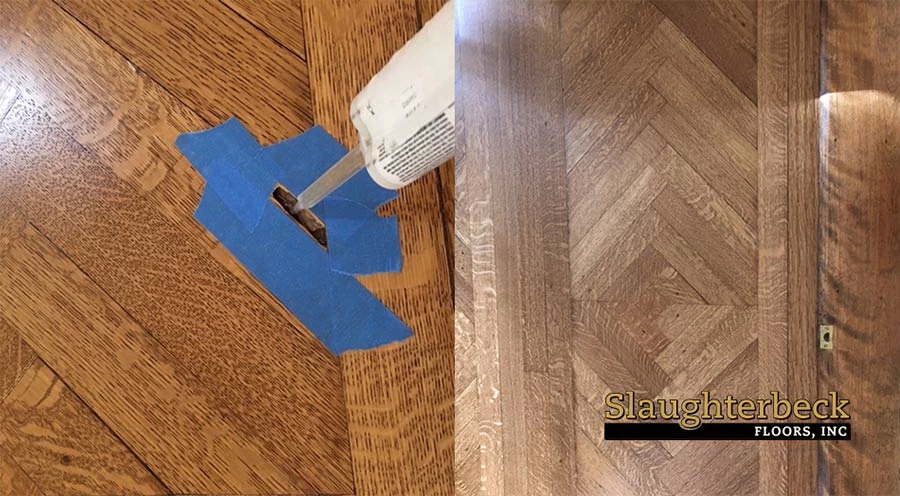
Repairing Hole in Hardwood Floor
Filling in Gaps in Wood Floor Boards
Filling in gaps is an important step in the floor refinishing process, as it can help improve your floors’ appearance and durability. Gaps between floorboards can occur naturally over time due to changes in temperature and humidity or as a result of the floorboards shifting or settling.
To fill in gaps, your floor refinishing professional will typically use a wood filler or putty that matches the color of your floor. We will carefully apply the filler to the gaps between the floorboards, using a putty knife or other tool to ensure that the gaps are completely filled.
After the filler has been applied, it will need to dry completely before the floor can be sanded and refinished. The drying time can vary depending on the type of filler used, the humidity level in the room, and other factors.
While filling in gaps can help to improve the appearance of your floors, it may not eliminate all gaps or prevent new ones from forming in the future. However, regular maintenance and upkeep can help to minimize the occurrence of gaps over time.
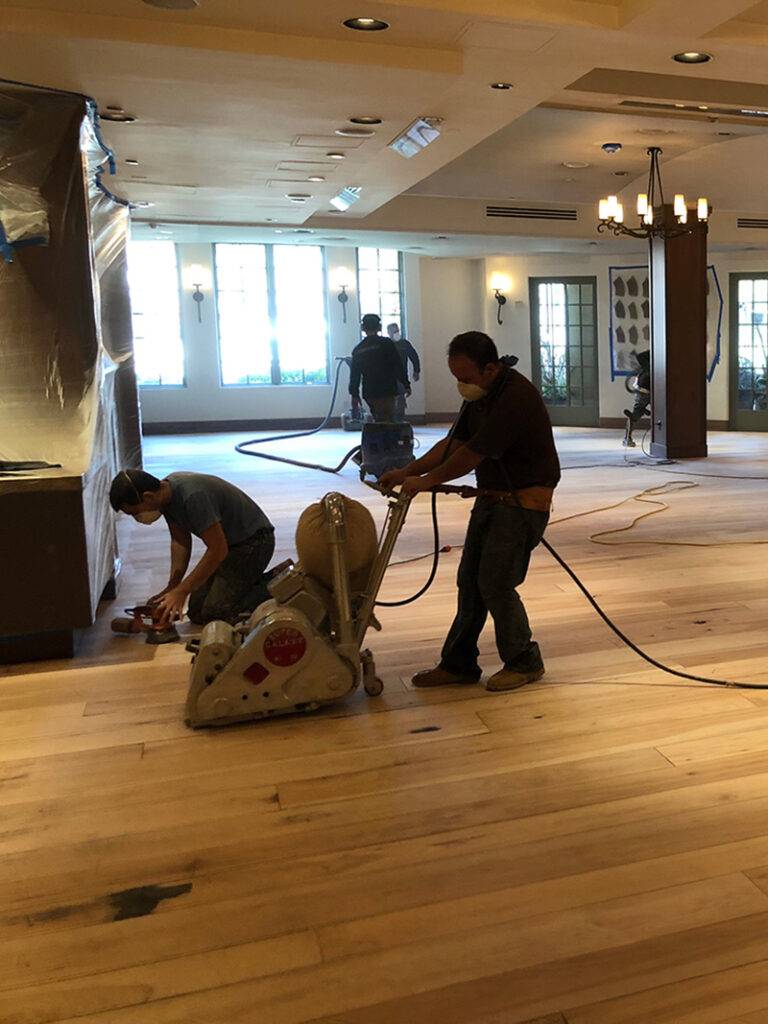
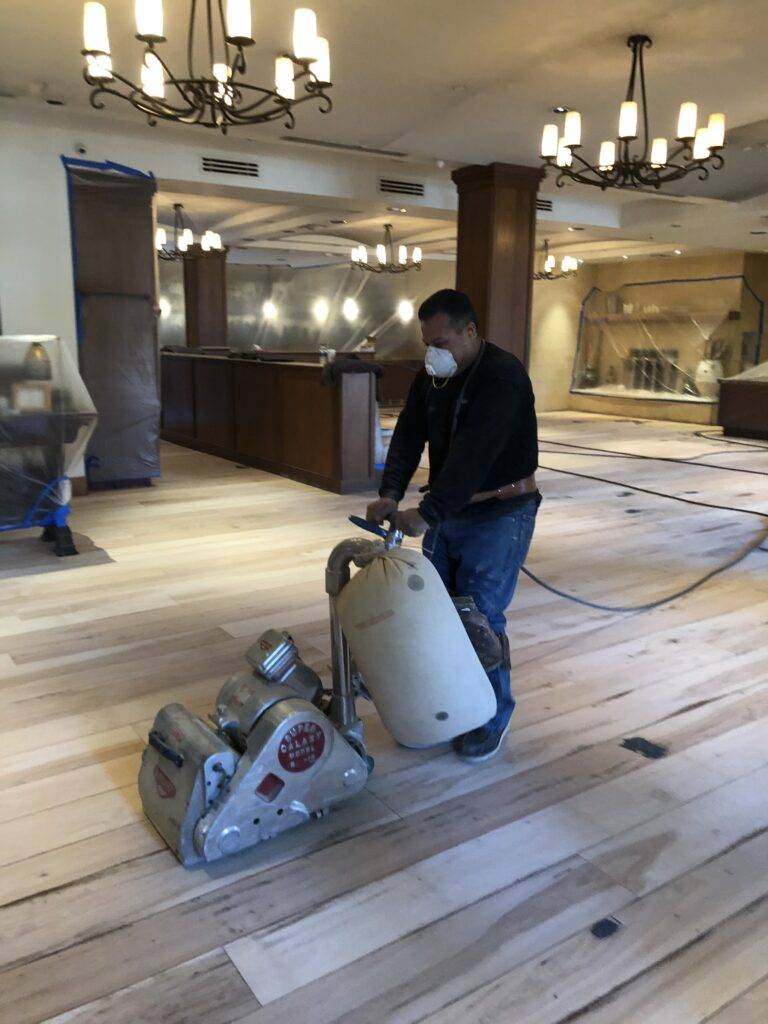
The Slaughterbeck Floors hardwood refinishing crew sanding the floors at Dio Deka restaurant in Los Gatos
Managing Dust During Hardwood Floor Sanding
When sanding hardwood floors, dust is a significant concern for many homeowners and business owners. The sanding process can create a lot of dust, spreading throughout the house. Dust can also settle on the newly stained floors and create an uneven finish.
While there is no truly dustless system, we implement the most comprehensive isolation/cleaning methods possible, along with modern sanding machines, dubbed “dustless sanders,” to ensure dust is minimized as much as possible before complete vacuuming. These modern sanding tools capture the dust as it is created, preventing it from spreading. We also use plastic sheeting to seal off the room being worked on.
After the sanding process is complete, the floor will need to be thoroughly cleaned to remove any remaining dust. This is typically done using a combination of brooms, vacuums, and tack cloths. It’s important to remove all dust before applying the new finish to the floor.
Overall, while dust can be a concern during the refinishing process, there are steps that can be taken to minimize its impact and ensure a successful outcome and dust-free home once you return.
How Many Times Can a Hardwood Floor be Refinished?
A solid hardwood floor can withstand sanding and refinishing five to seven times, and in some cases even more, depending on its thickness and condition. The sanding depth required for each refinishing project can vary from shallow to deep, depending on the surface’s condition. For instance, shallow sanding can remove the old finish to make way for a new stain, extending the sanding and refinishing count even further.
However, for heavy scratches and damage, deeper sanding may be necessary to repair the surface. It’s essential to avoid sanding beyond the wear layer, which is typically around 5/16″ thick, to avoid exposing the nails that secure the wood to the subfloor.
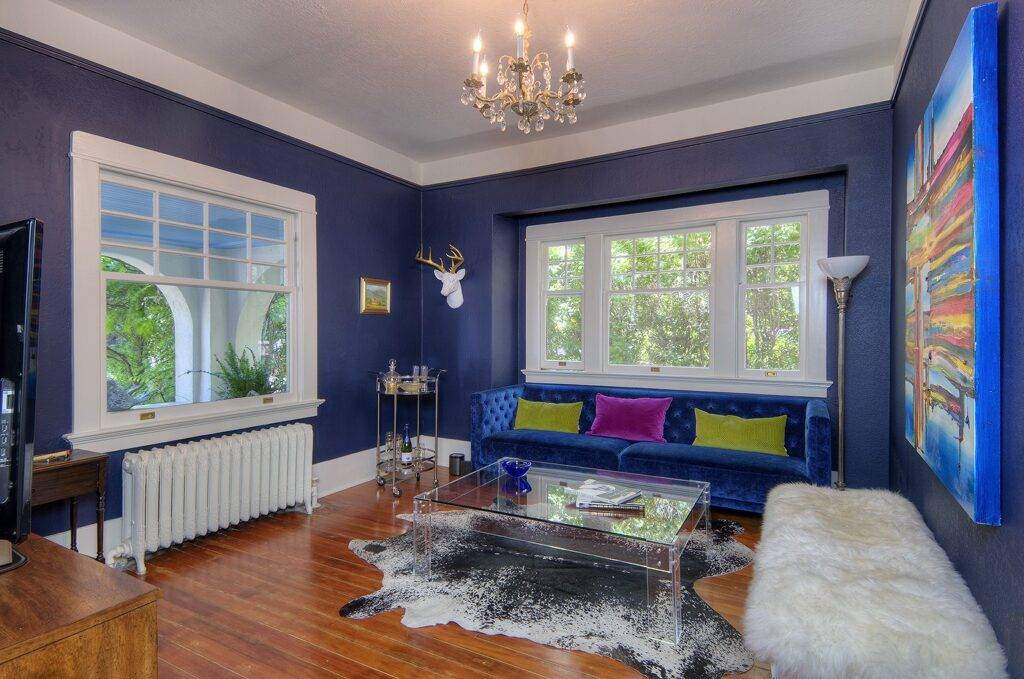
Refinished Douglas Fir Hardwood Floor done by Slaughterbeck Floors in Family Room of Los Gatos, CA Home
Design+Remodel: Clayton Nelson & Associates
Can Engineered Floors Be Refinished?
Most engineered wood floors cannot be refinished due to their construction. While there are some exceptions to this rule, they are quite rare. Engineered wood floors have a top layer of hardwood veneer, which can only withstand a limited amount of sanding before the surface is compromised. Therefore, attempting to refinish most engineered floors can cause irreparable damage.
How Long Does the Hardwood Sand & Refinishing Process Take?
The length of time it takes to refinish hardwood floors depends on several factors, including the size of the area, the type of wood, the extent of the damage/ wear, and the refinishing method used. In general, the process of refinishing hardwood floors takes about 3 to 5 days per 1,000 square feet.
If we need to repair or replace damaged boards, this may add to the overall time it takes to complete the project.
Additionally, the type of finish you choose can affect the length of time it takes to complete the refinishing process. Some finishes take longer to dry in between coats, adding more days to the overall timeline.
Overall, it’s best to consult with a professional hardwood floor refinishing contractor to get a more accurate estimate of how long the process will take for your specific project.
How Long Should You Wait Before Walking on Refinished Floors? When Can Furniture be Moved Back in Place?
The time it takes to walk on your hardwood floor after refinishing depends on the type of finish used and the weather conditions. Typically, you should wait at least 24 hours before walking on the floor with socks and at least 72 hours before walking on it with shoes.
However, following the manufacturer’s instructions for the specific finish used on your floor is best, as some finishes may require more time to dry and cure properly.
In terms of moving furniture back, it’s recommended that you wait at least 72 hours after refinishing before moving heavy furniture back onto the floor for water-based finishes. For most finishes, we recommend 96 hours for oil-based finishes. This will allow enough time for the finish to cure and harden fully, reducing the risk of damage to the newly refinished surfaces.
Area rugs may be moved back after 4 weeks once the finish is fully cured.
It’s important to follow the manufacturer’s recommendations and the advice of your flooring professional to ensure the best results and minimize any potential damage.
| Sand & Refinish | Screen & Coat |
|---|---|
|
Can walk with socks after 24 hours, 72 hours with shoes
|
Can walk with socks after 24 hours, 72 hours with shoes
|
|
Move furniture back after 72 hours (water-based finish) or 96 hours (oil-based finish)
|
Move furniture back after 72 hours (water-based finish) or 96 hours (oil-based finish)
|
|
Move area rugs back after 4 weeks once the finish is fully cured
|
Move area rugs back after 4 weeks once the finish is fully cured
|
How to know when it’s time to refinish hardwood floors?
Some sources may recommend the water drop test to know when to refinish hardwood floors. But the water droplet test will only indicate whether you have finish on the floor. How bad a floor looks and how damaged is really the best way to tell when it’s time.
For reference, the water drop test: place a couple drops of water on the floor. Beading indicates there is a finish (doesn’t really indicate that you do not need to refinish) while soaking in indicates no finish.
Should I replace or refinish my hardwood floors?
If 20 to 30 percent or more of your hardwood flooring is damaged, or if you simply want a completely new look, replacing the floor is often a better option than refinishing it.
When is the Best Time of Year to Refinish Hardwood Floors?
Floors can be refinished any time of year but some details should be considered before scheduling.
While we use dustless sanding systems with HEPA filters, there will still be some dust, so the best time is always before moving into a new home.
In addition, it’s recommended to open windows and run fans during the sealing process as the polyurethane, despite low VOCs, still has a mild odor. The polyurethane finish will also take a bit longer to dry when the air is humid.
Slaughterbeck Floors is your go-to flooring store for hardwood floor refinishing services in the greater San Jose Bay Area. Whether you want to return your floors to their original luster or give them a new look, we have the expertise and eco-friendly products to do the job right!
Contact us today for a consultation, and let’s breathe new life into your older hardwood floors.
Customer Testimonials



Punctuality, Quality, Responsiveness, Value
We had our hardwood floors refinished. Could not be more pleased with he quality and professionalism of this company. Jose went over and beyond our expectations. This was a complex job and he gave 150% effort to make sure I was happy with the results. I believe I have found he best! When we replace our carpet I’ll be callng them😀

We’re in Campbell, but our customers include larger cities from hardwood flooring in San Jose to engineered hardwood in Palo Alto.
Our full service area includes:
Santa Clara County: Cupertino, Gilroy, Los Altos Hills, Mountain View, Santa Clara, Campbell, Los Altos, Los Gatos, Milpitas, Monte Sereno, Morgan Hill, Palo Alto, San Jose, Saratoga, Stanford, Sunnyvale
San Mateo County: Atherton, Belmont, Burlingame, Foster City, Menlo Park, Redwood City, San Carlos, San Mateo, Woodside
Alameda County: Fremont, Newark, Union City (please call for other cities)
Santa Cruz County: Aptos, Capitola, Pasatiempo, Santa Cruz, Scotts Valley, Soquel

